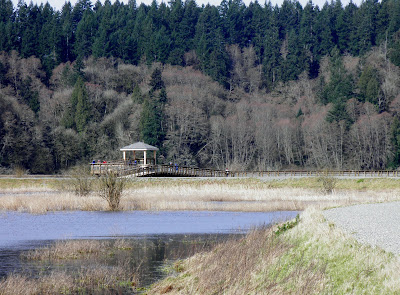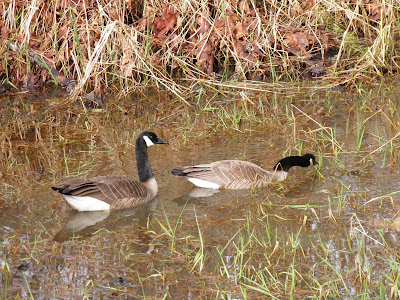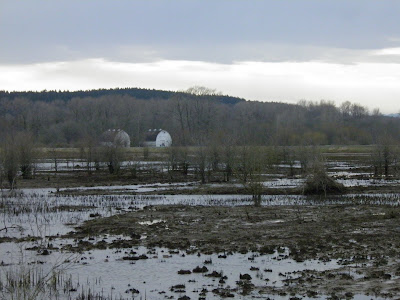Ramblings around Washington State. Natural wonders of my world. I am forever trying to learn. Strong caution, pictures of plants may include bugs,spiders and other "creepy" things. Natural history plants flowers bugs birds biologies. Geology weather conservation and gentle hikes.
About Me
- Upupaepops
- Just a meandering soul sharing my backyard. Visit my Flickr page too! www.flickr.com/photos/meanderingwa/
Thursday, March 31, 2011
...Tra La
Tuesday, March 29, 2011
The Flowers That Bloom in the Spring...
I lucked out on my plans for the weekend. I was thinking now is a good time for the Eastern Washington early blooms. The Pass report mentioning snow, traction tires and even snow in Wenatchee put the damper on that bit of enthusiasm. I decided to focus closer to home and pretty much everyone can guess I went up to Washington Park, my favorite Spring venue.
You will be proud of me for strictly obeying the speed limit on Hwy 20 from I-5 to Anacortes.
A few weeks ago we visited without a hint of Spring on the grounds. Only a few Red Currents waiting for Hummingbirds. Saturday was a different story. The best part is that it didn't rain a lick and I actually got a bit too warm in my hike around the loop. Now flowers are starting.
I encountered a camera club having their first meeting and getting to know their cameras. I encouraged them to visit the park often and clued them in on some of the best spots for nature study.
Along the south face of the park the path to the Serpentine slope holds a treasure trove of mosses and ferns. It is here that Fawn Lily grows in abundance. This day there were two flowers already up and dozens of buds just breaking through the moss carpet. It is interesting to see that these flower buds are already quite white when they are erupting from the ground and not encased in a greenish cover, like so many lilies. All over the mottled leaves give promise of the bounty that will cover this path. It is here that I also find Calypso Orchids, but they are still quite tucked in underground.
Other early blooms include the impossibly small Blue-eyed Mary. These love the open slopes along the south face and happily tuck themselves into every rocky foothold. If moss grows on the surface, the Blue-eyed Mary appears nearby.
Paths along the south face are a little misleading. Many of them are blazed by deer and can take you to spots you do not recognize. There is always the potential to see something from a new perspective. The deer trails certainly show you where the more sturdy footing is. The superficial soil, characteristic of the south rock face, can be plenty treacherous. This Pacific Juniper makes a fantastic sculpture. On the slope the Juniper and the Madrone are the dominant species.
Yellow Monkey flower was up an blooming. They love the steep rocky walls and seem to have the longest bloom period of the showy flowers.
I followed some deer tracks and came upon a secluded break in the trees. Here I found a nice population on Satin-flower ( Douglas' Blue-eyed Grass). These flowers have an early and short blooming life. They time with the Blue-eyed Mary and Spring Gold. The "satin" in its name comes from the sheen the petals have.
Field Chickweed grows in abundance. I think it is a pretty little backdrop for the more showy, less common flowers.
I am glad I followed the little deer trail. It led me out onto a trail into the woods. "I know this trail" I thought and I looked down to my right. And there it was, exactly where one was last year. The first blooming Calypso Orchid of the year. Last year I spotted one here , very early in March. It was my first wild orchid spotting of the year then as well.
Monday, March 28, 2011
More "Offerings to the Wind" Art
Sunday, March 20, 2011
Long Walk on a Long Pier












Saturday, March 12, 2011
Ivy Pull
I spent the morning with the Nisqually Land Trust pulling English Ivy on one of their properties.
This little property is right along side the freeway, just before it enters the Nisqually National Wildlife Refuge. February of last year we did some of the same type work on an adjacent property. I wrote about that day with the enchanting houses and the charming artistist who live on that property.
If you look back you will see that it was a glorious sunny day. Today was quite a different story. Rain, rain rain. I think this is storm five in the chain of ten storms slated to come our way over the next week. Thankfully the wind was not blowing, but there was no hope of keeping remotely clean or dry.
English Ivy invades and runs. Its biggest damage potential comes when it climbs trees. The strong thick runners form solid mats around the trunk and between the weight of the plant and the choking off of circulation these vines can bring down a tree.
Because the creek that passes through the property is a salmon stream, the trees are vital to protect and maintain the water temperatures. They also help filter the toxins in the environment.
We focused on clearing the ivy from around the trunks in a girdling like pattern. Leaving a gap of about 2 to three feet between the ivy high in the tree and the ground will result in death for the higher ivy. I focused on the newer growth with my hand clippers. Others used saws and pick-axes to pry vines as stout as my arm from the sides of the trunks. The ground around the trees could benefit from having the vines pulled up as well. It is a daunting task. Everything you see here that is clear, bare dirt was ivy when we started.
Unlike last year the woods are not quite up to speed. Indian Plum is blooming, but there is very little fresh new growth. The native snails are asleep. I did find some tiny, fresh turkey tail fungus.
This remarkably bright cup fungus earned a new home in a rotten tree trunk.
I didn't get an opportunity to take many pictures. My hands were muddy and my camera collected its own wet and grim even inside my pocket. My coat is not waterproof and why I am putting off actually getting suitable clothes for this task is beyond me.
I could not resist taking a picture of these lovely Violas. They are a garden species and not native. No one is particularly worried about their presence.
After visiting Washington Park last week , I revisited my blog entries from last year at this time. What a difference our somewhat normal weather this winter has made. Last year we had a mild, wet, non-winter with hardly any cold, freezing temperatures.
Last year at this time Washington Park was already in bloom with flowers everywhere. Last week I could not find a one, thought I found plenty of evidence that they will be here soon!
Monday, March 7, 2011
Washington Park Anacortes
It is that time of year. If you followed my blog last year you might remember the multiple visits to this gem of a park. I went to see what the status of the wildflowers is for this La Nina year. This point of land is part of the upper Puget Sound area that got hit hard several times this winter with snow and wind events.
I saw a lot of new green bits that are going to Spring into those wonderful Deer Lily and Orchids from last year. All over the south facing slope new growth of all wildflowers is poking up.
In the woods there is a lot of evidence that the wind storms of the last week kept the rangers busy clearing the road and paths. Some of the minor trails still have fallen trees to duck around. Overall it is less than I would have thought. Only the strongest live on this point of land.
Given the variety and vast views, it was also a chance to play with my camera again. When I was underway, I sadly realized that I left my glasses at home. Gaaaah!
And I got my first speeding ticket on the highway ( Gaaaaah !! ). Tricky part about being on a divided highway after coming off the freeway where you have been doing the legal 70. ( grrrrr)
Enjoy the show.
First part of the walk goes along the Guemes Channel, looking out to the San Juan Islands.
It is always possible you might see Black Oystercatchers here.
Making my way to the wonderful south side. This Towhee greeted me. I only got two shots, he was so busy.
This bench at Burrows Channel overlooks the Rosario Strait and the confluence of the Strait of Juan de Fuca. You can sometimes spot Orca from here.

